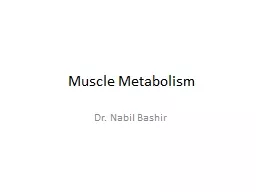

Learning objectives Understand how skeletal muscles derive energy at rest moderate exercise and strong exercise Recognize the difference between aerobic and anaerobic oxidation Recognize the three energy systems and exercise ID: 920762
Download Presentation The PPT/PDF document "Muscle Metabolism Dr. Nabil Bashir" is the property of its rightful owner. Permission is granted to download and print the materials on this web site for personal, non-commercial use only, and to display it on your personal computer provided you do not modify the materials and that you retain all copyright notices contained in the materials. By downloading content from our website, you accept the terms of this agreement.
Slide1
Muscle Metabolism
Dr. Nabil Bashir
Slide2Learning objectives
Understand how skeletal muscles derive energy at rest, moderate exercise, and
strong exercise .
Recognize the difference between aerobic and anaerobic oxidation
Recognize the three energy systems and exercise
Recognize the source of ATP production and metabolic pathways operating at resting and working
Understand the importance of
cori
cycle and glucose-alanine cycle
Understand the molecular basis of
Becker and Duchenne muscular dystrophy
Muscle Glycogen Storage Diseases: Type V (McArdle Disease ), and
tyoe
IIV
fatty acid oxidation disease: Carnitine
palmitoyltransferase
II (CPT II) deficiency,
Slide3100%
% Capacity of Energy System
10 sec
30 sec
2 min
5
+
min
Energy Transfer Systems and Exercise
Aerobic Energy System
Anaerobic Glycolysis
ATP - CP
Exercise Time
Slide4Energy Metabolism
Aerobic
With oxygen
Source of energy: mainly
fatty acids
, then carbohydrate
CO2, H2O & ATP
Anaerobic
Without oxygenSource of energy: Carbohydrate (glycolysis)
Lactate & ATP
Slide5Figure 10–20a
Slide6Resting Muscle and the Krebs Cycle
Resting muscle fibers typically takes up fatty acids from the blood stream.
Inside the muscle fiber, the
FA’s
are oxidized (in the
mitochondria
) to produce Acetyl-CoA & several molecules of NADH and FADH2Acetyl-CoA will then enter the Krebs cycle (in the mitochondria) CO2, ATP, NADH, FADH2, and oxaloacetateNADH and FADH2 will enter
the Electron Transport Chain. (in the inner mitochondrial membrane) synthesis of ATP
Slide7ATP use in Working Muscle
As we begin to exercise, we almost immediately use our stored ATP
For the
next 15 seconds
or so, we turn to the creatine-phosphate.
This system dominates in events such as the 100m dash or lifting weights.
Slide8Working Muscle
After the phosphagen system is depleted, the muscles must find another ATP source.
*
The process of
anaerobic metabolism
can maintain ATP supply for
about 45-60s.Glycogen Glucose 2 pyruvic acid (2 ATP + 2 NADH)2 Pyruvic acid 2 lactic acid (2 NAD+)Lactic acid diffuses out of muscles blood taken by the liver
Glucose (by gluconeogenesis) blood taken by the muscle again* It usually takes a little time for the respiratory and cardiovascular systems to catch up with the muscles and supply O2 for aerobic metabolism.
Slide9Muscle Metabolism
Figure 10–20c
Slide10Aerobic Metabolism
Occurs when the respiratory and cardiovascular systems have “caught up with” the working muscles.
Prior to this, some aerobic respiration will occur thanks to the muscle protein,
myoglobin
, which binds and stores oxygen.
During
rest and light to moderate exercise, aerobic metabolism contributes 95% of the necessary ATP.Compounds which can be aerobically metabolized include:Fatty acids, Pyruvic acid (made via glycolysis), and amino acids.
Slide11Slide12THE CORI CYCLE
&
THE GLUCOSE-
ALANINE CYCLE
Slide13The Cori cycle
Liver
converts
lactate
into
glucose
via gluconeogenesisThe newly formed glucose is transported to muscle to be used for energy again
Slide14Slide15The glucose-alanine cycle
Muscles produce:
Pyruvate
from glycolysis during exercise and
NH2
produced from normal protein degradation produce
AlaninePyruvate + NH2 Alanine
This alanine is transported through the blood to liverLiver converts alanine back to pyruvateAlanine – NH2 = Pyruvate
Pyruvate is used in gluconeogenesisThe newly formed glucose is transported to muscle to be used for energy again
Slide16Slide17The Glucose-Alanine Cycle
What happened to NH
2
?
Liver converts it to urea for excretion (urea cycle)
Slide18Becker and Duchenne muscular dystrophy
Mutations in the dystrophin gene
BMD is a less-severe disease (patients are still walking after 16 yrs)
DMD is a more-severe disease (patients are not walking at 12 yrs)
both can be caused by massive deletions in the dystrophin gene (as well
as other types of mutations)
the severity is not necessarily correlated with the size of the deletion
18
Slide19mutations causing BMD can be very large in-frame deletions
5’
3’
truncated but functional protein with intact N- and C-termini
5’
3’
mutations causing DMD can be small out-of-frame deletions
C-terminal truncated protein (with out-of-frame translation product)
partially functional dystrophin protein
non-functional dystrophin protein
19
Slide20Metabolic myopathies
Heterogeneous group share the common feature of
inadequate
production of cellular energy in the muscle.
20
Slide21Muscle Glycogen Storage Diseases
Type V (McArdle Disease ): Deficiency of
phosphorylase:
an elevated CK (8,404 U/L; normal, 30–220 U/L),
mild elevations of aspartate aminotransferase (75 U/L; normal, 15–41 U/L), and alanine aminotransferase (82 U/L; normal, 17–63 U/L).
Urinalysis is negative for myoglobin.
Type VII: Deficiency of phosphofructokinase→hemolytic anemia and myogenic hyperuricemia. accumulation of normal glycogen in muscle, and abnormal glycogen
21
Slide22Fatty Acid Oxidation Disorders
FAO (b-oxidation of fatty acids) is the major source of energy during periods of sustained,
low-intensity exercise
or
prolonged fasting
.exercise intolerance and myoglobinuria are the most common presenting features. The major disorders of lipid metabolism that present with isolated myopathy include: Carnitine
palmitoyltransferase II (CPT II) deficiency,
22
Slide23CPT II
The severity of disease appears to be related to the type of mutation.
Missense mutations : production of some partially functional enzyme activity →milde myopathic form.
protein truncating mutations produce the more severe phenotypes.
Serum CK levels are usually normal
23
Slide2424